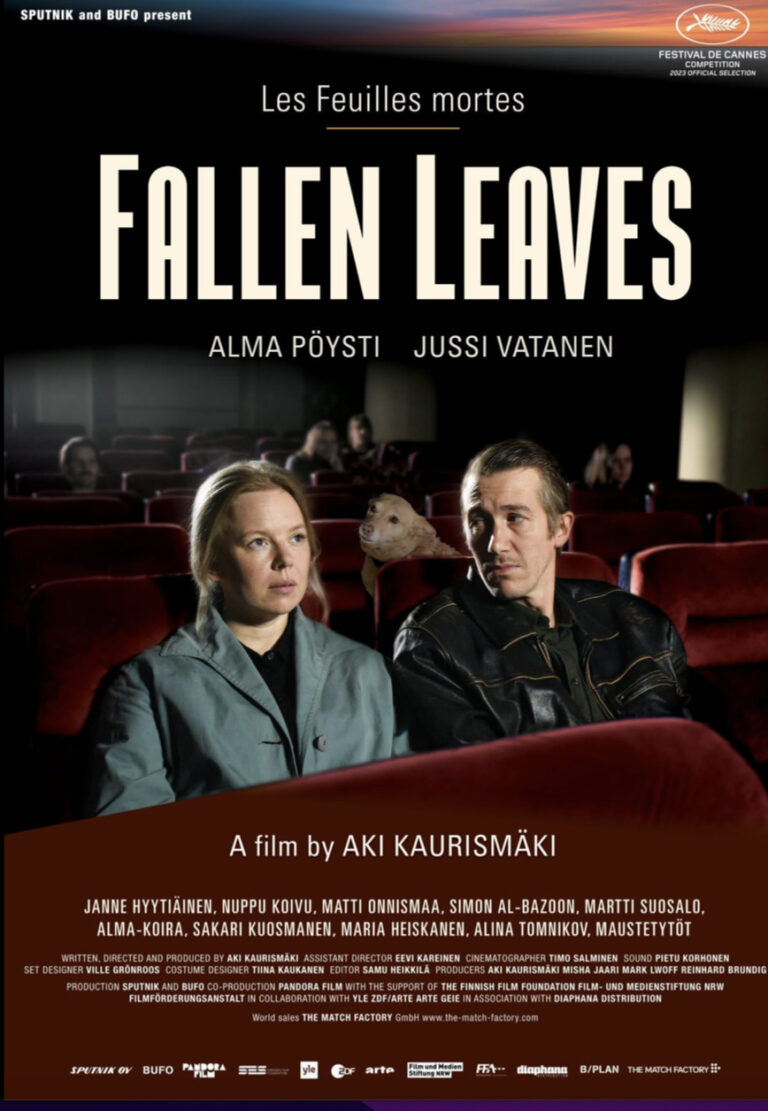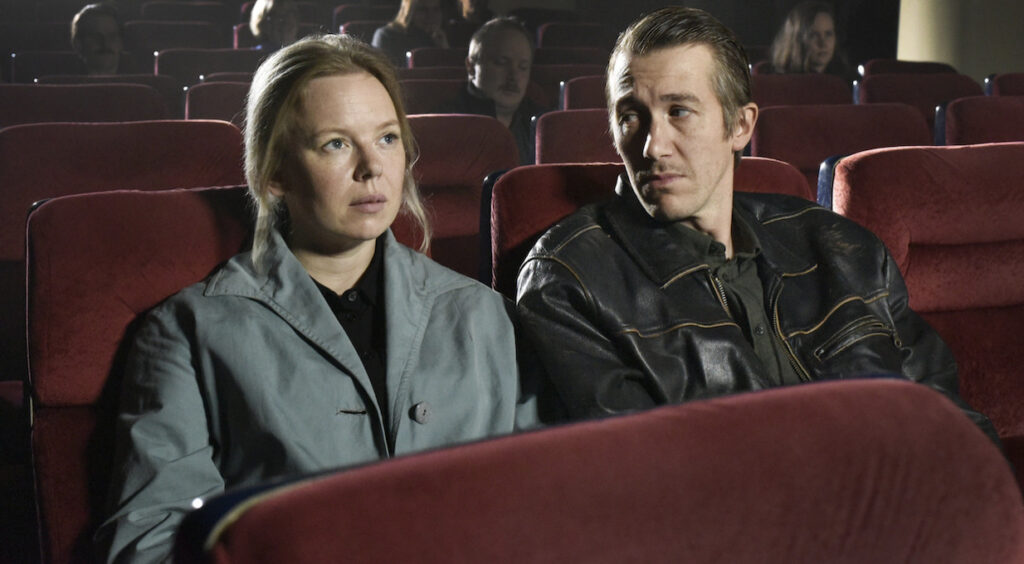
Ansa and Holappa, the quiet loners in “Fallen Leaves”, are on their first date watching Jim Jarmusch’s zombie movie “The Dead Don’t Die” in the local Ritz movie theater. Coming out, someone makes an absurdly amusing comparison: “it reminded me of “Diary of a Country Priest”, Robert Bresson’s classic. Ansa gives Holappa her phone number on a piece of paper but won’t reveal her name. The wind blows it away and he spends several anxious evenings smoking outside the cinema hoping, romantically old style, she would pass by.
Aki Kaurismäki, the legendary leading voice of Finnish cinema, is back. With “Fallen Leaves” he puts a love story at the center and pays tribute to cinema’s greatest while pointing out the “bloody war” in Ukraine. And rest assured, his unique cinematic world is basically the same as it has been for more than 35 years. Infused is his trademark minimalistic cool and bleak spirit, spiced with distinctive deadpan humor and warm humanism. His marginalized outcasts dealing with everyday struggles are once again depicted with tragi-comic tenderness.
In 2017 Kaurismäki claimed that “The Other Side of Hope” would be his last film. He changed his mind. “Fallen Leaves” makes a fourth addition to his “Proletariat Trilogy” – comprising “Shadows in Paradise” (1986), “Ariel” (1988) and “The Match Factory Girl” (1990). Looking like the 60s, but we’re in present time, Ansa works in a supermarket and is fired for trying to take home an expired sandwich. Back in her apartment in the rundown yellow house in Helsinki she burns her microwave food and can only afford 29 minutes at an internet café. At a joint on Karaoke night, with customers without face expressions (one singing out Schubert’s “Serenade”), she meets shy construction worker Holappa played by Jussi Vatanen, a Finnish equivalent to Ryan Gosling.

He doesn’t want to sing because “tough guys don’t sing” – “you are not a tough guy, says his friend. The two lonely souls find a quiet heartwarming connection which could be a salvation in their grim reality but is jeopardized by Holappa’s fondness for drinking hard liquor. He says to his best friend Houtari (Janne Hyytiäinen), who doesn’t know his first name: “I drink too much because I’m depressed, and I’m depressed because I drink too much”. Holappa already lost a few of his physically demanding jobs because of it and Ansa, who lost her father and her brother to alcohol and her mother to heartbreak because of it, leaves him until he is “sober as a decent rat”.
Where love is concerned, Kaurismäki finds hope for his broken characters. In contrast to “The Match Factory Girl” (with regular Kaurismäki actress Kati Outinen), the two blue collar workers in “Fallen Leaves” do find some light in love. This time Kaurismäki is more romantic than in a long time. The title “Falling Leaves” comes from the old French song “Les feuilles mortes”, which is also heard in the film. Their almost wordless connection is incredibly moving, simple and yet profound. Their restrained performances are beautifully acted by Alma Pyösti who is best known for “Tove” (2020) and Jussi Vatanen, a household name in Finland. Both making their first Kaurismäki film appearance. There are other familiar faces. Showing up are “Compartment No. 6” director Juho Kuosmanen and the leads in “The Other Side of Hope,” Sherwan Haji and Sakari Kuosmanen, who is a long-term Kaurismäki regular. As usual, Kaurismäki’s characters are not dramatic, don’t move much, don’t say much, and smoke a lot with straight-faces – “people talk too much anyway” Kaurismäki declared once.
Most of the talk comes from the vintage analog radios in both Ansa’s and Holappa’s apartments (televisions or computers are not around). The news of the Russian invasion in Ukraine is broadcast and there is a lot about the horror in Mariupol. They are of course bothered a lot about it, especially Ansa. The war is very real for them – Finland has a long border with Russia. Kaurismäki’s worldview is clear.
His humanism always shines through and his respect for conventions is low. In “Le Havre” (2011) and “The Other Side of Hope” he put refugees in the center. It seems impossible for someone like Kaurismäki to not comment on the war in Ukraine. “If we don’t have humanity we couldn’t exist or even shouldn’t exist” he said earlier this year.
His trademark is portraying working class underdogs and their struggles. Yet their struggles are bathed with empathy (and cigarette smoke), and they find hope in the hardships of everyday life.
In their world, red lightens up the bleakness. The color is very present this time – everywhere from sofas, handbags, jackets and the bar wall, to lighters and old telephones at the hospital. The regular Kaurismäki cinematographer Timo Salminen uses his static camera to capture nothing more than is necessary – the simple beauty and glimpses of light in people’s dim reality. Homages to movie masters are also woven into his films as Kaurismäki typically likes to reference classic cinema. Here he makes it more visibly. It’s not only his film guru Robert Bresson and the Frenchman’s simplicity he nods to, but also Chaplin (it’s the name of Ansa’s dog’s too), Buster Keaton, Yasujirō Ozu and his mutual admirer Jim Jarmusch. In the cinema lobby hang posters of Bresson’s “L’argent” and David Lean’s “Brief Encounter”. For our two loners cinema is an escape. For Kaurismäki it’s about people who try to survive in the world they were born into. To find a little hope in the hopeless, the humane in the lonely stripped down ruthless world. There’s humor in the failure, little beauties in life.

Grade: A-

